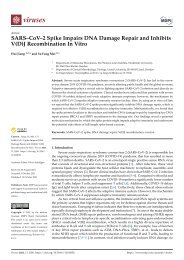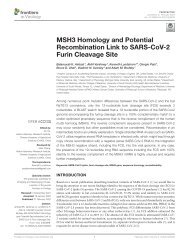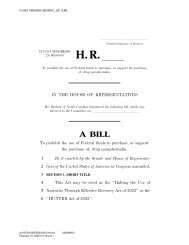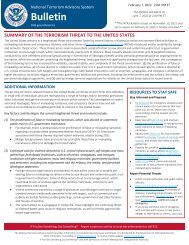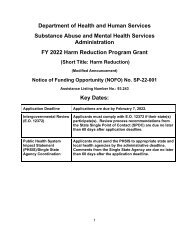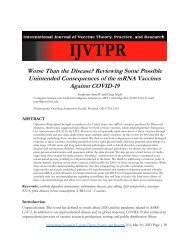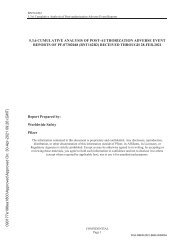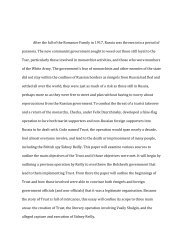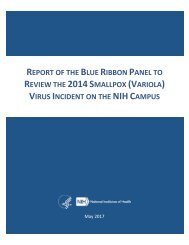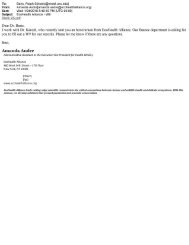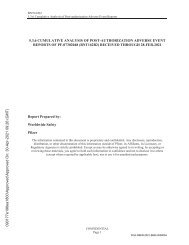A Literature Review and Meta Analysis of the Effects of Lockdowns on COVID 19 Mortality
You also want an ePaper? Increase the reach of your titles
YUMPU automatically turns print PDFs into web optimized ePapers that Google loves.
Today, it remains an open questi<strong>on</strong> as to whe<str<strong>on</strong>g>the</str<strong>on</strong>g>r lockdowns have had a large, significant effect<br />
<strong>on</strong> <strong>COVID</strong>-<strong>19</strong> mortality. We address this questi<strong>on</strong> by evaluating <str<strong>on</strong>g>the</str<strong>on</strong>g> current academic literature<br />
<strong>on</strong> <str<strong>on</strong>g>the</str<strong>on</strong>g> relati<strong>on</strong>ship between lockdowns <str<strong>on</strong>g>and</str<strong>on</strong>g> <strong>COVID</strong>-<strong>19</strong> mortality rates. 3 We use “NPI” to<br />
describe any government m<str<strong>on</strong>g>and</str<strong>on</strong>g>ate which directly restrict peoples’ possibilities. Our definiti<strong>on</strong><br />
does not include governmental recommendati<strong>on</strong>s, governmental informati<strong>on</strong> campaigns, access<br />
to mass testing, voluntary social distancing, etc., but do include m<str<strong>on</strong>g>and</str<strong>on</strong>g>ated interventi<strong>on</strong>s such as<br />
closing schools or businesses, m<str<strong>on</strong>g>and</str<strong>on</strong>g>ated face masks etc. We define lockdown as any policy<br />
c<strong>on</strong>sisting <str<strong>on</strong>g>of</str<strong>on</strong>g> at least <strong>on</strong>e NPI as described above. 4<br />
Compared to o<str<strong>on</strong>g>the</str<strong>on</strong>g>r reviews such as Herby (2021) <str<strong>on</strong>g>and</str<strong>on</strong>g> Allen (2021), <str<strong>on</strong>g>the</str<strong>on</strong>g> main difference in this<br />
meta-analysis is that we carry out a systematic <str<strong>on</strong>g>and</str<strong>on</strong>g> comprehensive search strategy to identify all<br />
papers potentially relevant to answer <str<strong>on</strong>g>the</str<strong>on</strong>g> questi<strong>on</strong> we pose. We identify 34 eligible empirical<br />
studies that estimate <str<strong>on</strong>g>the</str<strong>on</strong>g> effect <str<strong>on</strong>g>of</str<strong>on</strong>g> m<str<strong>on</strong>g>and</str<strong>on</strong>g>atory lockdowns <strong>on</strong> <strong>COVID</strong>-<strong>19</strong> mortality using a<br />
counterfactual difference-in-difference approach. We present our results in such a way that <str<strong>on</strong>g>the</str<strong>on</strong>g>y<br />
can be systematically assessed, replicated, <str<strong>on</strong>g>and</str<strong>on</strong>g> used to derive overall meta-c<strong>on</strong>clusi<strong>on</strong>s. 5<br />
2 Identificati<strong>on</strong> process: Search strategy <str<strong>on</strong>g>and</str<strong>on</strong>g> eligibility criteria<br />
Figure 3 shows an overview <str<strong>on</strong>g>of</str<strong>on</strong>g> our identificati<strong>on</strong> process using a flow diagram designed<br />
according to PRISMA guidelines (Moher et al. (2009). Of 18,590 studies identified during our<br />
database searches, 1,048 remained after a title-based screening. Then, 931 studies were excluded,<br />
because <str<strong>on</strong>g>the</str<strong>on</strong>g>y ei<str<strong>on</strong>g>the</str<strong>on</strong>g>r did not measure <str<strong>on</strong>g>the</str<strong>on</strong>g> effect <str<strong>on</strong>g>of</str<strong>on</strong>g> lockdowns <strong>on</strong> mortality or did not use an<br />
empirical approach. This left 117 studies that were read <str<strong>on</strong>g>and</str<strong>on</strong>g> inspected. After a more thorough<br />
assessment, 83 <str<strong>on</strong>g>of</str<strong>on</strong>g> <str<strong>on</strong>g>the</str<strong>on</strong>g> 117 were excluded, leaving 34 studies eligible for our meta-analysis. A<br />
table with all 83 studies excluded in <str<strong>on</strong>g>the</str<strong>on</strong>g> final step can be found in Appendix B, Table 8.<br />
3<br />
We use “mortality” <str<strong>on</strong>g>and</str<strong>on</strong>g> “mortality rates” interchangeably to mean <strong>COVID</strong>-<strong>19</strong> deaths per populati<strong>on</strong>.<br />
4<br />
For example, we will say that Country A introduced <str<strong>on</strong>g>the</str<strong>on</strong>g> n<strong>on</strong>-pharmaceutical interventi<strong>on</strong>s school closures <str<strong>on</strong>g>and</str<strong>on</strong>g><br />
shelter-in-place-orders as part <str<strong>on</strong>g>of</str<strong>on</strong>g> <str<strong>on</strong>g>the</str<strong>on</strong>g> country’s lockdown.<br />
5<br />
An interesting questi<strong>on</strong> is, “What damage lockdowns do to <str<strong>on</strong>g>the</str<strong>on</strong>g> ec<strong>on</strong>omy, pers<strong>on</strong>al freedom <str<strong>on</strong>g>and</str<strong>on</strong>g> rights, <str<strong>on</strong>g>and</str<strong>on</strong>g> public<br />
health in general?” Although this questi<strong>on</strong> is important, it requires a full cost-benefit study, which is bey<strong>on</strong>d <str<strong>on</strong>g>the</str<strong>on</strong>g><br />
scope <str<strong>on</strong>g>of</str<strong>on</strong>g> this study.<br />
5




